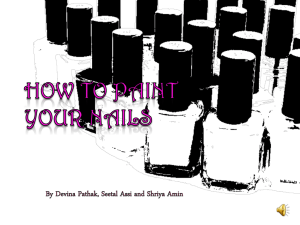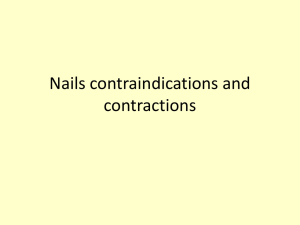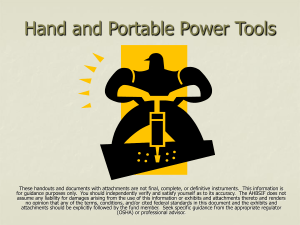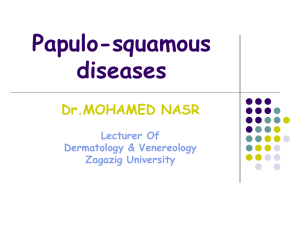Dermatology for the podiatrist - Intermountain Medical Center / VA
advertisement
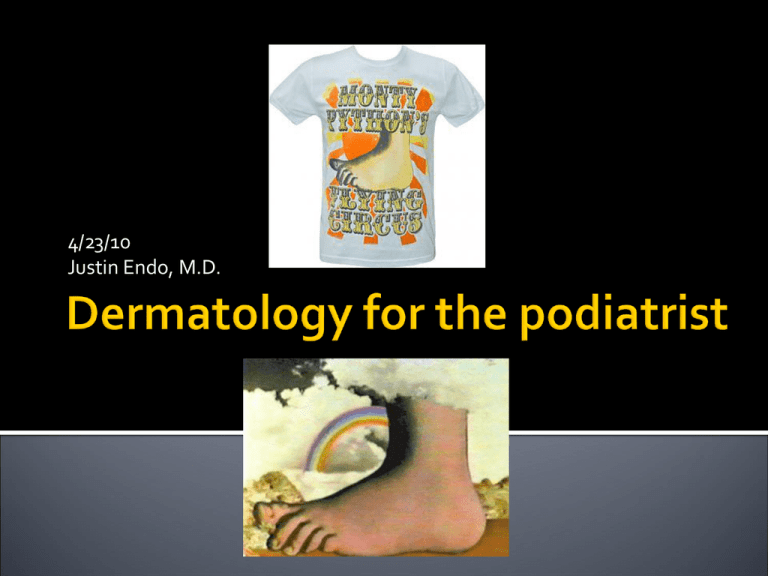
4/23/10 Justin Endo, M.D. No financial disclosures Primary reference and images unless otherwise specified from Bolognia et al. Diagnose dermatologic conditions affecting the lower leg Discuss management options Understand the limitations of biopsies, especially shave biopsies, using standard breadloaf histologic grossing methods Describe a lesion and consult dermatology appropriately Immune-mediated destruction of vessels Often classified by vessel size involved Small: ▪ Sometimes renal involvement ▪ Palpable purpura Medium/large: ▪ +/- systemic symptoms ▪ Ulcers ▪ Livedo reticularis ▪ Nodules Dermatology and/or rheumatology consult to help rule out systemic involvement If systemic involvement (or severely symptomatic small vessel disease without renal involvement) Steroids or other immunosuppressants Compression stockings for small vessel vasculitis Capillaritis Various morphologies Annular telangiectasias (Majocchi) Cayenne pepper petechiae and macules (Schaumberg) Eczematoid patches (Ducas and Kapetanakis) Lichenoid patches (Gougerot and Blum) Treatment Observation Topical steroids rarely helpful Clinical features Pathergy (sterile pustule at sites of trauma) Wound or ulcer that keeps getting “infected” despite debridement Undermining and rolled borders Cribiform healing Erythematous margins Bullous and granulomatous variants Associated conditions Inflammatory bowel disease Hematologic malignancy (bullous variants) Paraproteinemia Up to 50% idiopathic Diagnosis of exclusion Infectious etiology workup needed Biopsy will not RULE IN diagnosis but RULES OUT other causes of chronic ulcer Treatment NO DEBRIDEMENT!!! NO DEBRIDEMENT!!! NO DEBRIDEMENT!!! Dermatology consult Steroids (often systemic) Immunosuppressives Kaposi’s sarcoma Squamous cell carcinoma Melanoma Basal cell carcinoma Cutaneous lymphoma Abnormal endothelial neoplasm caused by human herpes virus 8 (HHV-8) Pink, black-violet nodules, plaques, or polyps 4 variants Chronic/classic (Mediterranean) African endemic Iatrogenically immunocompromised (CyA) AIDS related Childhood lymphadenopathic variant is fulminant and fatal Chemotherapy +/- XRT usually before surgery due to multifocality Malignant infiltration of keratinocytes Risk factors: Immunosuppression (transplant) Sun damage Can follow nerves, invade into bone, and metastasize Refer to dermatology to discuss treatment options, regardless of biopsy “margins” Answers.com Rarer type of melanoma Significant proportion of melanoma type in Asian and African skin Brown to black macule with irregular borders, color variegation, longitudinal melanonychia Consider biopsy Fair-skinned individuals Width >=3mm Changing lesion Staging / prognosis depends upon Histologic Breslow depth Lymph node involvement Mitotic rate Ulceration Treatment Wide local excision Sentinel lymph node biopsy for melanomas > 1 mm Adjuvant treatments and clinical trials dermoscopic.blogspot.com/ Most common skin cancer Least likely to metastasize Recommend referral to dermatology, regardless of biopsy “margins” Surgical management depends upon histologic appearance An Bras Dermatol 2005 Abnormal, clonal T or B cell proliferation Violaceous nodules (B cell) or widespread eczematous-like plaques (T cell) Differential includes “pseudolymphoma” benign lymphocytic hyperplasia Referral to dermatology and hematology/oncology for treatment options Dermatofibroma Disseminated superficial actinic porokeratosis Kyrle’s disease Poroma Pink to brown dome shaped papules (sometimes flatter) that dimples when squeezed Thought to be reactive to trauma Management options Expectant (watchful neglect) Punch / excise Triamcinolone injection Cordran tape Multiple flesh colored, scaly papules or plaques with double edge rim of scale Malignant transformation risk is low Treatment is generally unsatisfactory Expectant (watchful neglect) Cryotherapy Topical 5-FU or imiquimod Topical retinoids Curettage VGDR.com Keratin perforates through skin ? form of prurigo nodularis associated with renal disease Treatment (difficult) Topical steroids Antipruritic lotions UV light Laser Emedicine.com Benign tumor of eccrine > apocrine duct origin Palmo-plantar vascular papules, nodules, plaques No treatment indicated (or excise if symptomatic) Lichen planus Psoriasis Purple polygonal papules and plaques, sometimes with lacy netlike Wicham’s striae Affects wrists, arms, genitals, buttocks, oral mucosa Association with hepatitis C, metal contact allergies, hepatitis B vaccine, medications Can be difficult to treat Topical steroids Light Antimalarials (hydroxychloroquine) Photos AAFP.org Oil spot Nail pit Polygenetic disorder Itchy, red, well-demarcated plaques with silvery scale involving the scalp, torso, umbilicus, gluteal fold, extensor extremities Often nail pitting and oil spots Sometimes involving genitals, axillae Rarely palmar or plantar distribution Uncommonly pustular or erythrodermic Triggers Trauma Infection (streptococcal, HIV) Hypocalcemia Drugs (lithium, interferon, beta blocker, systemic steroid, antimalarials) Major comorbidity: metabolic syndrome! Enthesitis Morning stiffness lasting at least 1 hour 5-30% of all psoriasis patients 15% of cases arthritis precedes skin lesions Categories Classic (DIP) Mono/asymmetric arthritis RA-like (small and medium joints) Arthritis mutilans Spondyloarthritis Depends upon extent/sites of skin disease, arthritis, comorbidities, lifestyle Topical steroids and vitamin D analogs Light Methotrexate Biologics (e.g., etanercept, infliximab, adalimumab, ustekinumab) Necrobiosis lipoidica (diabeticorum) Erythema nodosum Pretibial myxedema Yellow-red-brown plaques +/- atrophy or ulceration on shins NOT strictly associated with diabetes or glucose control Treatment Potent topical or intralesional steroid into active borders Niacinamide Light Surgery as last line Associated with hepatitis C Obtain hepatitis C antibody study and refer to hepatology eMedicine.com Tender, red, poorly demarcated, subcutaneous deep-seated nodules on anterior shins resolving like a bruise +/- arthralgias and fevers Typically young adults RARELY (if ever) ulcerates Usually acute and self-limited eMedicine.com Etiologies Infections (streptococcal and coccidioidomycosis) Inflammatory bowel disease Sarcoid Sulfonamides, halides, gold, sulfonylureas Behçet disease Pregnancy (2nd trimester) Lymphomas Treatments NSAIDs Elevation Compression Rest SSKI Colchicine Referral to internist or dermatologist to look for underlying etiologies www.Woundsresearch.com Excessive hyaluronic acid deposition in dermis, often pretibial legs Almost always associated with Graves disease (though only 0.5-4.3% of Graves patients) Firm, bilateral, nonpitting, pink-purple-brown plaques or nodules with follicular prominence +/- hyperhidrosis or hypertrichosis Rarely elephantiasis presentation Women > men eMedicine.com Dermatitis herpetiformis Bullous pemphigoid Pruritic pink eroded papules on extensor elbows and knees, buttocks Rare to see an intact blister because so itchy Gluten-allergy of skin Diagnosis by serology, skin biopsy for direct immunofluorescence Treatments Gluten-free diet Dapsone dermimages.med.jhmi.edu Often in older individuals Pruritic or painful, tense subepidermal bullae, sometimes affecting mucosa Sometimes presents as eczematous or urticarial lesions WITHOUT blisters Sometimes precipitated by medications (vancomycin, gold, furosemide, aldosterone antagonists) Diagnosis by serology, skin biopsy for direct immunofluorescence Treatments Remove offending medication, if identified Steroids Steroid sparing agents Tungiasis Larval migrans Purpuric glove and sock syndrome Mycetoma CDC Tunga penetrans flea infestation Caribbean, Africa, India, Pakistan, Central America, South America Invade through unprotected feet Edematous, painful, hyperkeratotic pustules and nodules Secondary infection, lymphangitis common Cryotherapy Electrodesiccation Antiparasitics (ivermectin, niridazole) Occlusive petrolatum Surgical eMedicine.com Hookworm “accidentally” infests barefoot human Ancylostoma, Uncinaria, Bunostomum Tingling and pruritic, serpiginous erythematous plaques Self-limited Prevention Thiabendazole Painful erythematous and petechiae/purpuric palmoplantar eruption +/- enanthem Unique viral eruption in children and young adults, often in springtime Parvo B19 Coxsackie B6 Human herpesvirus 6 (HHV-6) Symptomatic treatment Still (probably) contagious during rash Deep seated skin / soft tissue infection with draining sinuses and extruding grains Often from direct innoculation from dirt 3 delicious flavors Botryomycotic (true bacteria, staph, pseudomonas) Actinomycotic (filamentous organisms) Eumycotic (true fungi) Treatment Excision Appropriate antimicrobials based upon cultures Thanks to Dr. Jason Hadley for providing content Nails Learn to identify some common causes of nail disease Recognize concerning nail lesions Understand nails are a window to diagnosis of systemic disease A. B. C. D. Traumatic nail dystrophy Melanoma Drug induced pigment deposition Benign melanonychia New pigmented streak in light-skinned individuals Nail plate destruction Pigment on proximal nailfold (Hutchinson’s sign) Widening of existing streak A. B. C. D. E. Myxoid cyst Glomus tumor Traumatic nail dystrophy Onychomycosis Psoriasis Clinical features Proximal nail fold swelling Depression of nail plate Periodic clear drainage Connection to DIP joint Treatment Referral for excision Higher rate of recurrence with puncture and drainage Sclerotherapy Cryosurgery Intralesional steroid injections A. B. C. D. E. Chronic paronychia Pseudomonas infection Verruca Pyogenic granuloma(s) Periungual fibroma Key Points Bleeding angiomatous nodule Often related to trauma Associated with zidovudine and isotretinoin Treatment Excision Electrodessication and curettage A. B. C. D. E. Onychomycosis Lichen planus Trachyonychia Brittle nail syndrome Nail-patella syndrome Key points: Nails are thin with rough appearance Most often associated with alopecia areata Rarely associated with lichen planus and psoriasis Etiology not understood No effective treatment Self limited A. B. C. D. E. F. Psoriasis Nail findings of alopecia areata Pseudomonas infection Epidermolysis bullosa Lichen planus Darier’s disease Key points Nail pits seen in psoriasis, alopecia areata, atopic dermatitis Oil spots = psoriasis of nail bed Onycholysis Toenail findings indistinguishable from onychomycosis Treatment Systemic psoriasis treatments Intralesional triamcinolone to proximal nail fold A. B. C. D. E. Benign longitudinal melanonychia Minocycline-induced nail pigmentation Pseudomonas infection Laugier–Hunziker syndrome Post-inflamatory hyperpigmentation Key points: When drug-induced cause suspected, multiple nails should be involved Slate gray color is reassuring Rule out melanocytic process Treatment Color will return to normal 1-3 months after discontinuing drug A. B. C. D. E. Lichen planus Psoriasis Onychomycosis Chemotherapy-induced nail changes Trachyonychia Key points Lichen planus rarely affects nails Characteristic “pterygium” blunts lateral nail fold Nail thinning Treatment Triamcinolone Methotrexate • • Beau’s lines • Transverse depression on nail plate • Stressors Onycholysis • Splitting of distal nail plate from nailbed • Trauma, irritants, fungal infection • • Onychorrhexis • Brittle nail Onychomadesis • Complete proximal nailplate shedding • Systemic illness Emedicine.com • • Onychoschizia • Distal nailplate layer splitting • Fragility / trauma Darier-White • Hereditary • Red-white alternating longitudinal nailplate • V-nicking dermatology.cdlib.org • • Yellow nail syndrome • No cuticle, arrested growth • Lymphedema, respiratory tract disease • Vitamin E, itraconazole Koilonychia • Spooned nail • Anemia Dermatology.cdlib.org Muehrcke Paired white lines that do not grow outward Hypoalbuminemia Mees’ White band that grows out Heavy metal, renal failure Terry’s White proximal nail plate, red distally CHF, liver, diabetes Half & half White proximal nail plate, brown distally Renal failure Aafp.org Nail-patella syndrome LMX1B autosomal dom Dysplastic nails Patellar aplasia Elbow arthrodysplasia Iliac horns Proteinuria Emedicine.com



